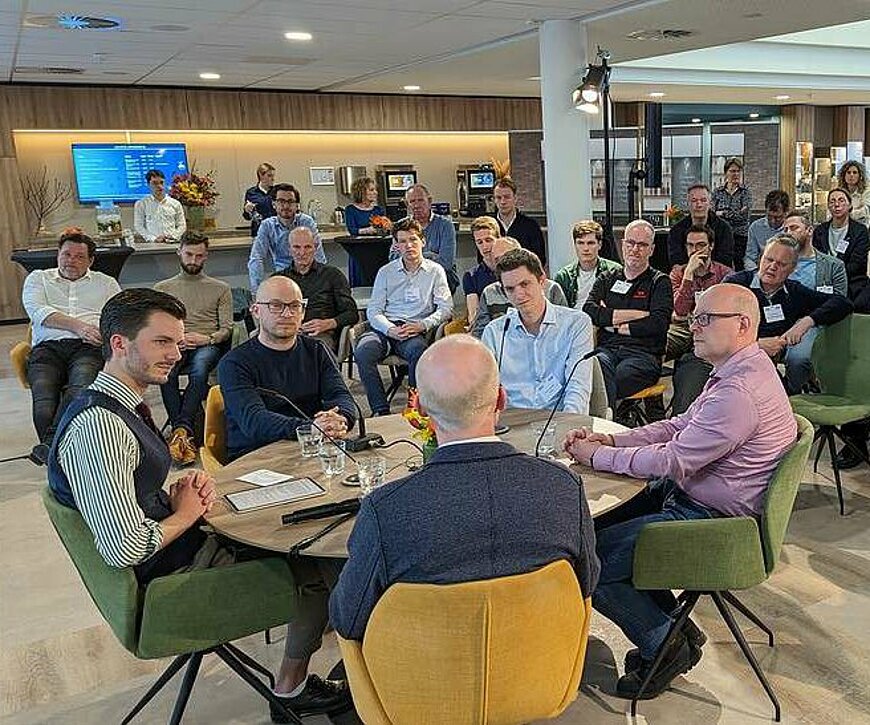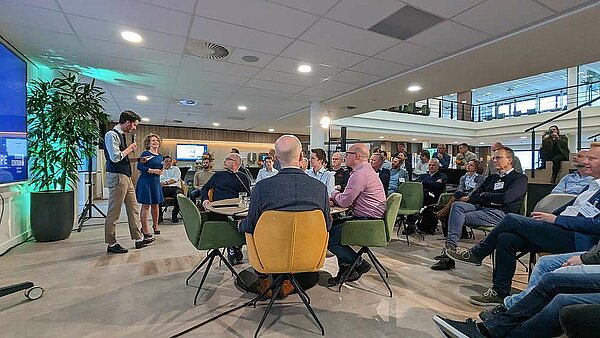AI in manufacturing: avoid a Sherlock Holmes syndrome

Mikrocentrum took an audience from the high-tech manufacturing industry into the world of AI with a new Techcafé. What can we do with it in the manufacturing company?
Artificial Intelligence is playing an increasing role in the manufacturing industry. By collecting, analyzing and applying data, companies can work more efficiently, save costs and deliver higher quality products. Examples include predictive maintenance, quality control, supply-chain optimization, robotics applications or smarter product design. By using these technologies, companies can improve their competitive position and better respond to changing market demands.
On April 20, Mikrocentrum and DSPE Techcafé took an audience from the high-tech manufacturing industry into the world of AI. What can we do with it in the manufacturing company? Where should we start, or have we already started? Maarten Roos engaged in a conversation with 4 experts:
Albert van Breemen - CEO/CTO at VBTI
Hugo Ploegmakers - Director of Product at AM-Flow
Frans Fonville - Lecturer of the Master Digital Technology Engineering, Fontys Hogescholen
Sjoerd van Agtmael - FMI ImProvia
It seems like everyone is working on artificial intelligence these days. While it was first reserved for webtech companies such as Google and Meta, this technology has now penetrated the world of manufacturing as well. "Digital technology is often driven by big tech, after which we as a society respond to it," says Frans Fonville. "As a society, we look at how we can incorporate it and benefit from it. But now we are to the point where we start using that digital technology ourselves. That's a different direction. No more technology push but the other way around; we are going to fill in and embed it ourselves. The starting point here is often a target group that you can help with digital technology."

0.2 seconds
But how does that work for the manufacturing industry? At AM-Flow, a lot of experience has now been built up with it. Hugo Ploegmakers: "For years we have been looking for ways to check the quality of the many thousands of products made with 3D printing. For a very long time this was done manually, but of course that is a huge job. With AM-Flow, we finally managed to create a model that is able to check every object in 0.2 seconds based on vision and machine learning. A human would need roughly half a minute to do that, so that business case is quickly clear." In doing so, AM-Flow uses both its own data and the customer's data. "And if we don't have enough data, we try to generate it, for example by deploying additional cameras."
Branching
Added to that is learning to understand where the strengths and weaknesses of AI lie and what that means for the way of deployment in your company, Albert van Breemen adds. "So define your goals. AI is great, but only if you know how you want to deploy it. For example, if you're using it to guide a certain vacancy process, make sure you don't just do that with data from old selection processes. Because then algorithm is going to work as it used to, while you're looking for someone who fits the developments that are yet to come." For a manufacturing company, this is sometimes difficult to understand, Van Breemen said. "AI is a field with all kinds of ramifications. We now employ 20 people, all with their own partial expertise. It's not like you can be an AI expert with a little bit of python and google experience. The high performance requirements of the high-tech industry require more than a little basic knowledge. You can then get to 90% at most, while 99.99999% is needed."
Growth market
Variation is thus an important condition for the useful deployment of AI in the manufacturing industry. In most parts of the manufacturing industry, such an approach is not yet an issue because of the uniformity and predictability of the process, says Van Breemen. "But if more variation comes there too, as with the tens of thousands of different products AM-Flow wants to monitor, then AI does come into the picture." Van Agtmaal agrees. " At the industrial level, we must continue to ask ourselves whether the machine can become self-learning; whether an AI can control the machine. There really still needs to be guidelines and safeguards around quality and safety."
Even though AI may then change jobs here and there and perhaps even make some redundant, that does not yet mean it poses a structural threat to employment, the panel notes. For that, the manufacturing industry is still too much a growth market, with more of a problem finding sufficient talent than there would be disappearing jobs. But that does not alter the fact that much can change. Ploegmakers: "We really do need to make sure that the people who are less digitally adept are not left by the wayside."
With VBTI, Van Breemen is now active in several industries. Horticulture is one of them: thanks to algorithms based on image recognition, robots can pick exactly the right fruit or cut leaves. Van Breemen: "In a greenhouse, every detail is different, the variation is extreme. A traditional algorithm cannot handle that, but AI can, thanks in part to its self-learning aspects. With this we remove a bottleneck that had been there for years. And we can finally properly automate jobs for which there is little demand - such as that of leaf cutter."
